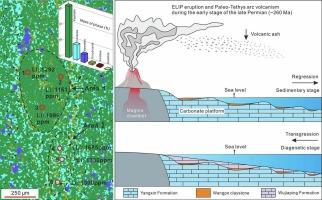火山灰对粘土型锂矿床形成的影响——华南上扬子北部地区晚二叠世粘土岩的约束
IF 3.6
2区 地球科学
Q1 GEOLOGY
引用次数: 0
摘要
粘土型锂矿床是全球主要的锂资源类型之一,可分为碳酸盐岩型和火山型两种类型。最近,在陕南、上扬子北部的上二叠统底王坡粘土岩中发现了一系列Li2O含量为0.13 ~ 0.39 wt%的粘土型锂矿床,已成为商业勘探的重点目标。但在物源、含锂矿物及其成因、锂富集机制等关键问题上尚不明确,阻碍了对王坡粘土岩中锂成矿作用的进一步认识。综合野外地质、岩石学、全岩地球化学、锆石U-Pb-Hf同位素和微量元素研究表明,王坡泥岩沉积于261 ~ 259 Ma滨浅海环境的碳酸盐岩台地上,经历了强烈的化学风化作用,未参与热液蚀变,其CIA值极高(98 ~ 99)。结果表明,王坡泥岩的微量元素组成和εHf(t)值(−8.8 ~ +5.6)均来自古特提斯弧,峨眉山大火成岩省(ELIP)贡献较小。全岩XRD和原位分析(SEM-EDS、TIMA和LA-ICP-MS)表明,高岭石(1096 ~ 1292 ppm Li)和cookeite (1390 ~ 1730 ppm Li)是王坡泥岩中主要的Li载体。矿物共生和形态特征表明,自生高岭石是由火山灰化学风化作用产生的,火山灰溶解蚀变释放出锂。随后的埋藏成岩作用促进了高岭石在富锂条件下部分转化为库克石,推动了锂的富集。因此,王坡泥岩可能是华南地区独特的一种不同于碳酸盐岩型和火山型的粘土型锂矿床。研究结果表明,经化学风化和成岩蚀变作用的火山灰在粘土岩的锂矿化中起着关键作用,对今后的勘探开发具有重要指导意义。本文章由计算机程序翻译,如有差异,请以英文原文为准。

Volcanic ash contributes to the formation of clay-type Li deposits: Constraints from the late Permian claystone in the northern Upper Yangtze region, South China
Clay-type Li deposits are one of the major types of Li resources globally and can be genetically categorized into carbonate-hosted and volcanic-hosted sub-types. Most recently, a series of clay-type Li deposits with Li2O contents of 0.13–0.39 wt% have been discovered in the Wangpo claystone from the bottom of the Upper Permian, southern Shaanxi, northern Upper Yangtze, which have become key targets for commercial exploration. However, some key issues such as provenance, Li-hosting minerals and their origin, and Li enrichment mechanism, remain unclear to date, hampering a better understanding of Li mineralization in the Wangpo claystone. Herein, a comprehensive study of field geology, petrology, whole-rock geochemistry, and zircon U–Pb–Hf isotopes and trace element reveals that the Wangpo claystone was deposited on carbonate platforms in a littoral-neritic environment at 261–259 Ma, and underwent intense chemical weathering without involvement of hydrothermal alteration, as evidenced by the extremely high CIA values (98–99). Vitric fragments, coupled with the trace element compositions and εHf(t) values (−8.8 to +5.6) of euhedral zircons with uniform ages (∼260 Ma), collectively suggest a volcanic ash origin for the Wangpo claystone, primarily derived from the Paleo-Tethys arc with a minor contribution from the Emeishan Large Igneous Province (ELIP). Whole-rock XRD and in-situ analyses (SEM-EDS, TIMA, and LA-ICP-MS) demonstrate that kaolinite (1096–1292 ppm Li) and cookeite (1390–1730 ppm Li) are the primary Li carriers in the Wangpo claystone. Mineral paragenesis and morphology suggest that the authigenic kaolinite was produced by chemical weathering of volcanic ash, which was dissolved and altered to release Li. Subsequent burial diagenesis facilitated partial transformation of kaolinite into cookeite under Li-rich conditions, driving Li enrichment. Accordingly, the Wangpo claystone may represent a unique clay-type Li deposit in South China, distinct from both carbonate-hosted and volcanic-hosted types. This study highlights that volcanic ash subjected to chemical weathering and diagenetic alteration plays a pivotal role in Li mineralization of claystone, which could provide valuable guidance for future exploration and development.
求助全文
通过发布文献求助,成功后即可免费获取论文全文。
去求助
来源期刊

Ore Geology Reviews
地学-地质学
CiteScore
6.50
自引率
27.30%
发文量
546
审稿时长
22.9 weeks
期刊介绍:
Ore Geology Reviews aims to familiarize all earth scientists with recent advances in a number of interconnected disciplines related to the study of, and search for, ore deposits. The reviews range from brief to longer contributions, but the journal preferentially publishes manuscripts that fill the niche between the commonly shorter journal articles and the comprehensive book coverages, and thus has a special appeal to many authors and readers.
 求助内容:
求助内容: 应助结果提醒方式:
应助结果提醒方式:


